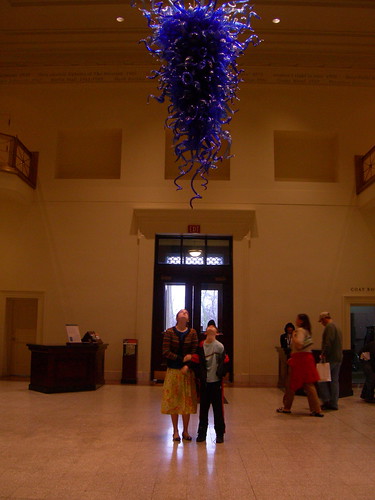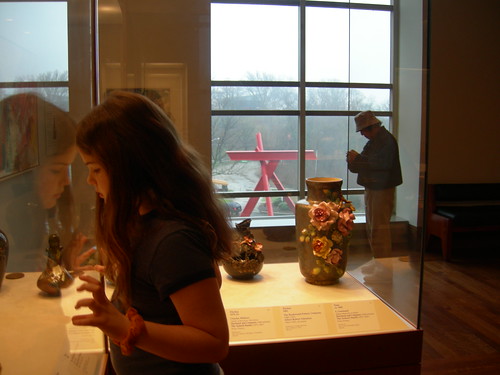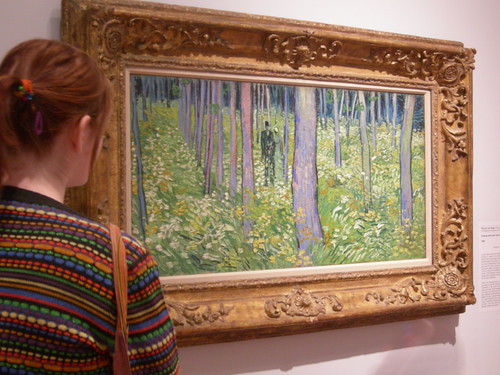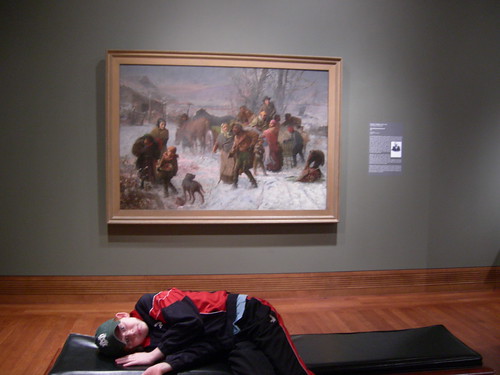
When we recommend going to art museums, sometimes parents wonder what it’s got to do with writing. Isn’t art its own course of study? Why would Brave Writer specifically promote it?
I promote the enjoyment and study of art because a visual vocabulary is critical to a verbal one. We’re primarily stimulated every day through sight. As we observe the world around us, we form impressions that inform our attitudes, beliefs, preferences and habits. Art uses a visual vocabulary to communicate. We’re awed by the precision of strokes (to an almost photographic accuracy) in some paintings and then moved by the blurry soft edges of impressionism that tend to evoke a mood more than provoke a compliment. We see color manipulated to create atmosphere, we observe other times and eras (habits of dress, style of architecture, expanse of nature). We get to see style (we can compare and contrast artists within one era, and we can compare and contrast artists of different eras).
These encounters are different than nature or TV or flipping through a photo album. Artists are deliberate in ways similar to authors.
- They select the point of view.
- They edit the scene in front of them, choosing what to paint and what to exclude.
- They pull from a palette of colors like authors draw from a lexicon of language.
- They tell a story through images.
- They create pathos or joy, indignation or peace.
And all we have to do is stand and look carefully, allow the painting to speak through its images.
For writing, having a rich visual vocabulary is just as important as having a big word-filled one. Words help to express images and images give rise to words. They partner together to create meaning.
A trip to an art museum also offers visuals to go with some of the legendary stories of our collective history. Together, paintings partner with language to create new levels of appreciation.
What follows, then, is a window into how frequent trips to the local Cincinnati Art Museum enhanced our home education.
Be not intimidated! Get the stroller and go. You’ll be glad you did.
2005
 One thing I love about Cincinnati is that the art museum isn’t that far away. We went to it yesterday for the afternoon. We’ve been many, many times. As we walked in the door, Liam exclaimed, “I love that Chihuly chandelier.” Jacob added, “I could look at it every day.”
One thing I love about Cincinnati is that the art museum isn’t that far away. We went to it yesterday for the afternoon. We’ve been many, many times. As we walked in the door, Liam exclaimed, “I love that Chihuly chandelier.” Jacob added, “I could look at it every day.”
We made our way into the Greek and Egyptian displays and Caitrin noticed that they had rearranged them. She went on to point out which of the vases she liked best compared to last time. Liam wanted to stop and look at each of the hieroglyphs again.
We moved on and went into an exhibit that was put up by Proctor and Gamble – all Cincinnati art. I honestly didn’t recognize the exhibit but the kids did. They started reminiscing about the pieces they had loved the last time we’d been there. We marveled at the quality of the artwork. Later we found an entire exhibit devoted to Frank Duveneck (Cincinnati native) and were thrilled to see all his paintings together. That was new.
We made our way upstairs to see the Monets that are on loan from Paris and were blown away by the size and colors. Caitrin immediately told me the story of why this particular “Bridge at Giverny” was so hard to see close-up – “because Monet lost his eyesight as he got older and he would make paintings that were less and less realistic as a result.” She pointed out how much the bridge showed up if we were at the back of the room compared to up close when we could see each swirl of the brush up close.

Liam reminded me of the “Linnea in Monet’s Garden” book we had read and Jacob remembered the movie we had checked out from the library. We were amazed that the Cathedral at Rouen was so dull close up and so vibrant at a distance. You could see the source of light behind it and it glowed from across the room.
We walked into the modern art exhibit and all agreed again that we don’t like modern art, except that I really like Mark Rothko. Rothko asserts that he isn’t interested in form, line, or color but in creating emotions. He says that he knows he communicates because when people look at his work, many report that they cry. Jacob, who couldn’t remember who Rothko was when I spoke of him last week, was eager to see our Cincinnati Rothko. He didn’t cry. He didn’t understand why anyone would. I didn’t cry either, but I did feel this weird surge in my chest.
Liam wanted to see a real Van Gogh so I took him to the only one in the museum. He remembered it then and commented that, “That guy must really have liked paint. I like his blue.” Caitrin added, “He uses globs of it. It’s nice to see the real painting so we can see the globs up close.” We wished for a Van Gogh exhibit to come to Cincinnati.

Our favorite rooms were closed for renovation. We were sad. So we went to other rooms we frequent less and noticed all the Italians. We discussed the benefits of great art being dispersed throughout the world rather than collected all in one town. We talked about why the Italians artwork was so much more dramatic than the British in the room next door. We shuddered in front of a boyish, rosy-cheeked David holding the recently severed head of a bloody Goliath.
We ended up in front of a painting that showed a woman deranged with a pale face, flowers dripping down her white gown, restrained by a man in a renaissance costume. They stood before a queen in anguish and a king with his face in his hands. Jacob called out, “Mom, this is from Hamlet! That’s Ophelia.” And it was. The man was Laertes, her brother. Apparently this artist had wanted to make a series of Shakespeare paintings to display together in England, but the project failed and the pieces he painted have been bought up by a variety of art connoisseurs. This painting is the first to have been purchased for the Cincinnati Art Museum and its purchase preceded the museum’s construction by about five years.
It was a great afternoon. And it was fun to see that repeated visits yielded so much in my kids.

























